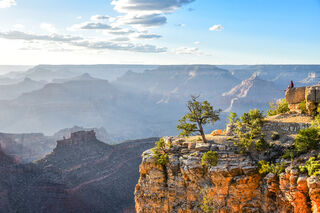Attention
A Photo of the Grand Canyon Could Depict How We View Others
How well do we know our team members?
Posted July 25, 2022 Reviewed by Jessica Schrader
Key points
- Diversity, equity, and inclusion work starts with a mutual engagement.
- Relationships take time to build.
- Observing our own thoughts before acting on them could be a healthy exercise.

One spring a few years ago, I visited the Grand Canyon National Park in Northern Arizona for the first time and was mesmerized by its magnificence. It was more than just “a big hole in the ground,” as some people would characterize it. It’s a natural wonder everyone should visit at least once in their lifetime. Because of its vastness, there are North and South Rims, which makes a Grand Canyon visit difficult to cover in a short period of time. From my experience, the Grand Canyon is serene in its grandeur, yet holds an indescribable deeper meaning within its vastness.
After gathering myself from my initial amazement over the Grand Canyon, I decided to start taking pictures from different angles. With my high-powered digital camera, I took enough shots and then began to review them. I soon realized that those photos could not do justice to the grandeur of the Canyon. As I compared the photos with actually viewing the Canyon, I found the details in the photos were not as elaborate as they were in live viewing. The feeling of awe that overwhelmed me as I looked down into the Canyon could not be felt by looking at the photos; especially, the whispers of the wind, the sound of the tree leaves being blown around by the wind, and the chirping of birds. All these sounds were experienced because of being present to the silence, tranquility, and serenity of the environment with an openness of the mind to appreciate the Canyon.
I began to wonder whether we as people ever take time to appreciate one another’s differences and similarities as we do with the Grand Canyon.
If we characterize ourselves as the Grand Canyon in a sense of being dynamic and sometimes indescribable, do we view each other as if we were experiencing the Canyon in person or as in the pictures taken? Introspect on how we perceive each other, and ask, “How much time do we spend trying to understand one another?” This question ought to provoke deeper meaning into how we understand one another, especially in the workplace, where we spend the majority of our time.
There are three possible ways to make sense of understanding and collaborating with one another: label change; slow down; and be open to new possibilities.
- Label change. Because we live in a society where labeling each other is intuitively a norm, we tend to label one another based on societal standards of acceptance, not through the lens of shared humanity. For example, giving each other the benefit of the doubt by perceiving everyone as a valuable member of society irrespective of demographic characteristics (e.g., religion, social status, gender, educational accomplishments, sexual orientation, etc.) can help us redefine how we treat each other. In terms of the Canyon illustration, if we step back from seeing the Canyon as merely a “big hole in the ground,” we can better perceive the Canyon for what it is: a massive natural wonder of the world. About 5.9 million people visit the Grand Canyon each year just to have an experience with the Canyon. Each one of us is deeper than our physical appearances. Sometimes, the nonstop noise in our minds never allows us to observe our thoughts; instead, we react to the first thought that comes to mind, and when we do that, we stand the risk of misjudgment.
- Slow down. Many men do not like to stay with their thoughts alone; women tend to be better at it. This could explain why more men get into trouble than women. Men often choose to engage in anything rather than staying idle, even if such engagements could result in negative and even unhealthy outcomes. Rushing to judgment generally leads to poor decisions, simply because we do not give enough attention to a situation, place, or person. Therefore, if we can slow our thoughts down and rethink our initial assumptions, we could start to see familiar information with a new lens. We can begin to pay attention to unspoken words usually expressed through body language only if we are intentional and empathetic in our everyday interactions.
Among people in positions of authority who wish to establish healthy relationships with their team members, only a fraction of managers can relate with their team members. This could be a good reason why we should lead from our heart and not our head because the heart knows what the head does not want to think about. But leaving the options open could help us be more flexible in our thinking, and to know how to apply both head smarts and heart smarts to our decisions.
- Be open to new possibilities. When we do things the way we have always done them, we end up seeing things the way we have always seen them. However, when we open ourselves up to get out of our heads and get into the realm of possibilities, we might learn from the least expected places. In the workplace, for example, during break time, workers have the tendency to congregate with their buddies. Making efforts to associate with co-workers who are not our contemporaries initially might feel unfamiliar and uncomfortable. With time and doing job tasks together, we might start seeing specific reasons to open up to each other. Every one of us has a particular trait that highlights our humanity. Our job is to make an honest effort to find that one thing. Once we focus on our similarities, the possibilities of appreciating others’ stories are heightened.
The Grand Canyon National Park receives more visitors every year from all over the globe than any influential person in the world, but it continues to remain true to itself. Humans have the capacity to entertain and accommodate one another because we have proven the possibilities over time. To keep attaining greatness, we can observe how we label one another, slow down to appreciate each other, and be open to new information. In these ways, we can then live up to our truest selves, and project such energy to one another—and be more than just a big empty space in others’ experience.
References
Allas, T., and Schaninga, B. (2020). The Boss Factor: Making the world a better place through workplace relationships, https://www.mckinsey.com/business-functions/people-and-organizational-p…
A Snapshot of the Grand Canyon Could Depict How We View Others in the Workplace Source: iStock; Simon Dannhauer, used with permission A Snapshot of the Grand Canyon Could Depict How We View Others in the Workplace Source: iStock; Simon Dannhauer, used with permissionIAPA. (2022). American Psychological Association: Labeling theory, https://dictionary.apa.org/labeling-theory
Brandenburger, A. (2019). Harvard Business Review: To Change the Way You Think, Change the Way You See, https://hbr.org/2019/04/to-change-the-way-you-think-change-the-way-you-…
Harter, J., and Adkins, A. (2015). Employees Want a Lot More from Their Managers, https://www.gallup.com/workplace/236570/employees-lot-managers.aspx
U.S. Department of Interior. (2017). 13 Things You Didn’t Know About Grand Canyon National Park, https://www.doi.gov/blog/13-things-you-didnt-know-about-grand-canyon-na…
Wilson, D. T., Reinhard, A. D., Westgate, C, E., Gilbert, T. D., Ellerbeck, N., Hahn, C., Brown, L. C., and Shaked, A. (2014). Just think: the challenges of the disengaged mind, https://www.ncbi.nlm.nih.gov/pmc/articles/PMC4330241/


